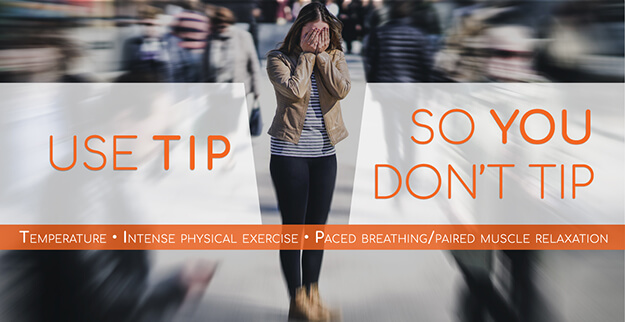
The distress tolerance skill, TIP, is useful during intense emotional moments when we are at a breaking point and are at risk to engage in reckless behavior. The emotion can be so overwhelming that we may do just about anything to escape it. Therefore, it will be necessary to do something immediately to calm down. This is when TIP skills are most useful.
T = Temperature
I = Intense Physical Exercise
P = Paced Breathing; Paired Muscle Relaxation
Temperature: When in an elevated state, cooling the body can be soothing. Dunking our heads in ice water, taking a cold shower, holding ice, or putting a cold compress on our face are all possible strategies to soothe and calm down.
Intense physical exercise releases the energy that is swirling around inside. One strategy is a 30-second intense exertion such as a sprint, followed by a 90-second recovery period of slow movement (walking). Do this 8 times.
Paced breathing means counting the seconds of your inhales and exhales and the pauses between them. The actual numbers that we use do not matter. The only thing to pay attention to is that we exhale longer that we inhale. The heart rate slows during the exhale and speeds up during the inhale. In this situation, we want to slow the heart rate.
Paired Muscle relaxation is paired with the breath. Start at the top or bottom of the body. Tense each muscle group for 5 seconds while inhaling and then relax while exhaling for longer than 5 seconds.
The mammalian dive reflex is a phenomenon in mammals in which heart rate slows while holding the breath in cold water. Humans will often slow the heart rate from the 70’s to the 30’s after 30 seconds of submerging the head in a tub of ice water. This is another way to slow the heart rate and promote a return to baseline.
TIP skills are useful when it is necessary to slow the body down when emotional arousal is high and heart rate is elevated.